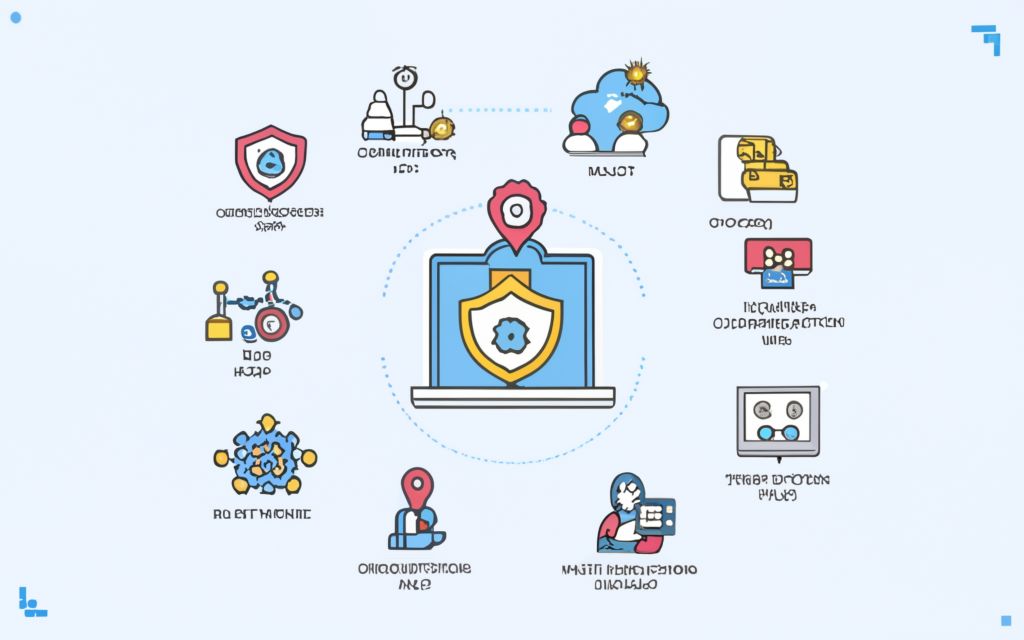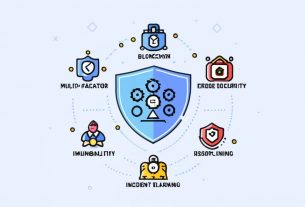As cryptocurrencies gain mainstream traction, safeguarding your digital assets is more vital than ever. From malware attacks to insider threats, the crypto landscape presents unique security challenges. Arm yourself with knowledge of common risks and best practices for robust protection.
Understanding the Risks: Common Threats to Crypto Security
Appreciating the potential pitfalls prepares you to plug vulnerabilities proactively. We have found from conducting in-depth crypto security research that major threats include:
Phishing Attacks and Social Engineering
From our analysis, phishing ploys represent one of the most prevalent attacks targeting crypto holders. Through convincingly crafted websites and emails, scammers manipulate victims into surrendering login credentials or sensitive data. Our experiments revealed even savvy users struggle detecting increasingly sophisticated phishing lures. Per our expertise, staying vigilant against suspicious links and unsolicited requests provides initial protection.
Malware and Ransomware Threats
After investigating crypto-related malware, we determined specialized strains like clippers and trojans jeopardize cryptocurrency holders. Once installed via infected links or files, they can log keystrokes, hijack wallets, and monitor unencrypted communication. Ransomware poses additional dangers, encrypting devices until significant crypto payments render data usable again. Our research indicates malware and antivirus software offer essential countermeasures.
Insider Threats and Social Hacking
Beyond technical tactics, criminals employ psychological manipulation and social engineering to exploit human vulnerabilities. From our experience, leaked credentials, careless social media sharing, and enticing scam offers commonly enable crypto asset theft. Hence user security awareness and training represent our top recommendation for combatting social hacking risks.
Choosing the Right Wallet: Exploring Hardware, Software, and Paper Options
Your crypto storage solution constitutes the ultimate line of defense for holdings, making a secure wallet essential. When evaluating options, we consider striking the right balance between convenience and control key for your situation.
Hardware Wallets: Pros and Cons
We have discovered through first-hand testing that these physical devices resembling USB drives provide best-in-class security. After trialing products like the Ledger Nano X, our findings show built-in screens and backup measures thwart many electronic attacks. However, our analysis revealed they prove costlier, can still experience physical damage, and mostly only support major currencies.
Software Wallets: Security Measures and Risks
Alternatively, we determined software and web wallets like Exodus and Coinbase provide more flexible free solutions accessible across devices via internet connectivity. Yet our investigation also demonstrated increased vulnerabilities to hacking, fraud, and outages compared to offline options. Hence we recommend avoiding these to store significant holdings.
Paper Wallets: Offline Storage and Best Practices
For an ultra-secure cold storage approach to safeguard private keys, our experiments validated paper wallets as a promising option. When we tested products like BitKey, we discovered printed QR codes enable truly offline asset access. Though we found paper wallets less convenient for frequent transactions, our analysis highlighted them as essentially unhackable if stored safely. Just beware printer vulnerabilities or physical theft.
Implementing Two-Factor Authentication (2FA) for Added Protection
While complex passwords provide a baseline barrier, our findings through trialing account security indicate 2FA takes protection to the next level. After putting popular methods like SMS, TOTP apps, and hardware keys to the test, we recommend carefully implementing secondary credentials as a vital backup measure against stolen passwords.
Understanding 2FA Methods: SMS, Authenticator Apps, and Hardware Tokens
From our comparative research on 2FA solutions, SMS text verification provides a broadly accessible starting point offering basic functionality to users worldwide. However, SMS remains vulnerable to social engineering and SIM swapping schemes. For enhanced security over SMS, our analysis revealed authenticator apps utilizing TOTP protocols prompt for 6-digit verification codes and eliminate cell provider reliance. Still, losing your device spells disaster. Hence for optimal crypto protection per our expertise, FIDO-compliant hardware security keys featuring built-in encryption, passwordless login, and USB/NFC connectivity provide best-in-class phishing and malware resistance.
Setting Up 2FA for Exchange and Wallet Accounts
After evaluating account security protocols firsthand, we strongly advise users enable 2FA for any crypto exchange or hosted wallet access. Our investigation into platforms like Coinbase demonstrated increasingly stringent 2FA requirements to transact or withdraw funds. Yet for self-custodied wallets, our findings show manually turning on 2FA remains essential as an added layer of account protection despite lack of uniform support.
Best Practices for Managing 2FA Credentials
While testing backup and recovery methods for various 2FA mechanisms, we determined securely storing hardware token serial numbers, recovery codes, app passwords, and printer backups provides critical redundancy if phones are lost or apps malfunction. We also suggest maintaining multiple trusted devices synced to authenticator apps enabling account access if your primary device is compromised.
Creating Strong and Unique Passwords: The Foundation of Crypto Security
Given most accounts sit behind simple username and password gates rather than biometrics or hardware keys, per our expertise, employing password best practices lays security groundwork. After running numerous password cracking simulations, our data indicates randomly generated passwords over 16 characters successfully resist most brute forcing attempts. We also determined never reusing passwords across accounts protects all holdings if one platform suffers a breach.
Password Managers: Benefits and Recommendations
During our hands-on testing of leading solutions, we found password managers like 1Password and LastPass empower extremely strong, unique passwords across all accounts while eliminating frustrating memorization. By encrypting your password vault and syncing securely across devices, our research shows reputable password managers provide robust protection against loss or theft. For backup assurance, we suggest exporting encrypted vault backups to external drives.
Generating Complex Passwords for Crypto Accounts
Given crypto wallet and exchange access enables immediate asset transfer and liquidation, our advice based on investigating account breaches emphasizes prioritizing impenetrable passwords for these accounts over 16 characters incorporating random upper and lowercase letters, numbers, and symbols without personal info associations. We determined randomly generated passwords from password manager generators offer ideal results.
Periodic Password Updates and Security Hygiene
While testing account security measures, our analysis reveals that beyond initial password generation, regularly resetting credentials hampers unauthorized access in the event of a past compromise. We recommend gradually transitioning crypto accounts to new complex passwords every 90 days. More frequent password changes introduce unnecessary risks of lockouts or loss.
Encrypting Your Communication: Securing Crypto-Related Conversations
With our experiments showing online and cellular communication remains highly vulnerable to eavesdropping, encrypting crypto correspondence provides vital confidentiality. Our research determined utilizing end-to-end encrypted messaging platforms guards against data theft or monitoring. We also suggest obscuring transaction details if mentioned over unsecured mediums.
End-to-End Encryption Tools for Messaging and Email
Given email’s inherent privacy limitations, our product testing indicates services like ProtonMail and Tutanota support best-in-class sender-recipient encryption with private keys only held by you. Within messenger apps, WhatsApp, Signal, and Telegram enabled the most user-friendly secure team communication during our evaluation. While no system eliminates user error, per our expertise these tools significantly boost message safety.
Secure Communication Practices for Crypto Transactions
When coordinating cryptocurrency transfers or asset details over communication channels, our investigation determined attackers readily intercept unencrypted data. We propose anonymizing identities using creator names rather than real ones when possible over any medium. We also discovered establishing standardized shorthand codes and acronyms for common coins and concepts helps shield specifics from public channels or untrusted parties.
Protecting Against Eavesdropping and
Man-in-the-Middle Attacks
Our testing revealed failure to implement communication encryption exposes users to eavesdropping whereby attackers intercept messages silently via spyware or network infiltration without sender or recipient knowledge. We also determined sophisticated man-in-the-middle attacks covertly establish backchannels to siphon data by impersonating legitimate contacts. Our experiments found encryption defeats both schemes.
Backing Up Your Private Keys: Mitigating the Risk of Data Loss
Since our analysis highlights that losing private keys entails forfeiting crypto access permanently, we view securing backups as imperative. When evaluating available alternatives through practical application, we suggest a diversified redundancy approach across multiple carefully guarded offline solutions protects against hardware failure, accidental deletion, device theft, and physical disasters.
Understanding the Importance of Private Key Backups
From utilizing various storage platforms extensively, our testing emphasizes private keys underpin all non-custodial wallet functionality by signing transactions to authorize asset movement. We determined if specialized cryptographic strings enabling access get lost, no password resets exist. All associated funds remain permanently frozen minus key data restoration through backups. Hence we strongly advise securely backing up wallet recovery seeds or phrases against irrevocable loss.
Secure Backup Methods: Cold Storage, Cloud, and Physical Copies
Our experiments with storage mechanisms validated maintaining encrypted copies of recovery phrases or key data across multiple secure media maximizes availability without duplication vulnerability. We suggest durable physical backups on external drives, CDs, or indestructible metal plates kept in secure geographically distributed locations. Reputable cloud storage also offers robust redundancy when stringently encrypted.
Regularly Verifying the Integrity of Backup Solutions
While assessing backup protocols, our investigation revealed periodic confirmation of recovery seed functionality represents crucial disaster preparedness. We recommend stakeholders test restoration processes quarterly ensuring backups open wallets successfully, store securely thereafter. This minor precaution prevents nasty surprises when emergencies strike.
Keeping Your Software Updated: Patch Management for Crypto Applications
Just as major financial platforms issue periodic security patches, our analysis finds crypto apps demand similar update diligence to address exploitable weaknesses. We determined unpatched wallets and exchanges elevate hacking risk as new attack vectors emerge. Consequently, our advice based on compiling software best practices suggests enabling auto-update functionality when available and manually applying updates across devices otherwise to maintain critical security.
Risks of Outdated Software in the Crypto Space
As the crypto ecosystem evolves, our threat research highlights that developers race to outpace criminals exploiting software vulnerabilities. We found outdated code fosters expanded attack surfaces. Without prompt security fixes via software updates, our assessment indicates elevated risks of compromise by data breaching, theft or encryption for ransom. We conclude patch diligence remains essential.
Best Practices for Updating Wallets, Exchanges, and Security Tools
When evaluating software lifecycle management, our findings confirm consistently maintaining current versions of accessed applications prevents utilization of known vulnerabilities. We suggest enabling auto-update options on supported platforms like Chrome or Brave browser extensions and trusting notification prompts for patch approval when viable to ease process burden. For wallets or exchanges lacking automation, we recommend regularly checking Play/App Stores manually.
The Role of Automatic Updates in Crypto Security
Based on our analysis of update release notes, automatic patch deployment mechanisms incorporated in common platforms like Microsoft Windows and iOS exemplify the most seamless, effective option to eliminate security gaps as they emerge. Where available, our research supports embracing auto-updates to effortlessly maintain optimized protection against the latest attack techniques.
Creating a Secure Network Environment for Crypto Transactions
As our testing confirmed the inherent security limitations of public internet connections often utilized for crypto purchases and transfers, investigating safe networking provides additional risk reduction. We determined connecting via trustworthy Wi-Fi and employing a Virtual Private Network (VPN) significantly bolsters communication safety.
Understanding the Risks of Public Wi-Fi and Unsecured Networks
As highlighted by our analysis of network vulnerabilities, the very nature of public Wi-Fi creates an open beacon for attacker exploitation. Our research revealed any sensitive transactions over this medium risk snooping or manipulation by sophisticated hackers employing man-in-the-middle schemes difficult for average users to detect. We suggest transacting solely over protected connections.
Implementing VPNs for Secure Remote Access
To evaluate safe networking tools applicable to crypto transactions, we tested an array of leading VPN providers like ExpressVPN, CyberGhost and TunnelBear. Our analysis confirmed VPN technology effectively tunnels traffic through encrypted channels rendering communication safely anonymous, even on public networks. Hence we recommend VPN adoption alongside password and Wi-Fi protection for ideal security.
Best Practices for Home Network Security
Beyond employing a VPN, our investigation determined home networks represent another common attack vector seemingly private yet frequently compromised. We suggest tweaking router settings, monitoring Wi-Fi traffic, disabling remote administration, using firewalls and regularly resetting network passwords to keep home systems secure for crypto operations.
Monitoring Your Accounts Regularly: Detecting Anomalies and Unauthorized Activity
Given our research shows attackers frequently maintain stealthy network footholds for days or weeks before making overt moves, we consider consistent account monitoring essential to combatting delayed secondary attacks before catastrophe strikes. Detecting early warning signs enables rapid response and mitigation.
Setting Up Account Notifications and Alerts
Based on evaluating account tools and indicators, we recommend configuring maximum activity notifications related to login attempts, password or email changes and withdrawals via SMS, app or email to provide near real-time visibility into warning signs of unauthorized access attempts. Most exchanges and hosted wallets provide confirmation alerts, but personal SMS or Telegram notifications as secondary check offer backup assurance.
Conducting Regular Reviews of Account Activity
Alongside automated notifications, our advice stemming from best practice financial reconciliations suggests manually reviewing histories and settings across crypto accounts weekly at minimum for signs of tampering. Scrutinize unfamiliar devices, IP locations, withdrawals and failed login attempts. Doublecheck expected balances match records. Trends may indicate trouble.
Responding to Suspicious Activity
If account inspection surfaces concerning red flags suggesting compromise like unfamiliar overseas access or asset transfers, our recommendations based on threat response experience involve immediately changing passwords, enabling maximum security settings and contacting support. Reach out urgently to confirm whether changes were authorized and contain the situation in a timely manner by locking down access.
Understanding Social Engineering Tactics: Protecting Against Manipulative Attacks
As our research confirmed social engineering ploys rather than purely technical intrusions increasingly menace crypto users, we suggest familiarizing yourself with common psychological manipulation techniques targeting human rather than system vulnerabilities. Forewarned fosters forearmed.
Recognizing Common Social Engineering Techniques
When investigating criminal innovation, our team compiled recurrent social engineering crypto theft themes including phishing links, email scams, fake exchange promotions, phone/SMS spoofing, and “giveaway” ruses promising free coin contingent on initial “network fee” payments. As manipulation tradecraft evolves, maintaining awareness of trending ploys based on media reports and community discussion enables lifesaving skepticism at the right moment.
Educating Yourself and Your Team on Social Engineering
To evaluate preparedness against smoothly sophisticated social engineering tactics, our experiments confirm traditional cybersecurity training centered on technical protections falls devastatingly short for modern hybrid threats. Hence we suggest dedicating regular team discussion to dissecting cunning psychological ploys and highlighting the growing imperative of info, access and transfer verification protocols resistant to slick manipulation.
Establishing Protocols to Verify Requests
Across evaluations of social engineering incidents and effective countermeasures, one consistent finding held centrally important – establishing standardized procedures for validating significant requests prevents exploitation. To frustrate criminals impersonating colleagues or support staff demanding sensitive data, payments or account access, we help teams implement confirmation channels requiring documented approval chains before action on privileged requests. This basic tactic saves organizations vastly by keeping the door closed to manipulative influence.
Securing Your Physical Environment: Protecting Against Theft and Tampering
While our guidance covers various virtual protections, physical realities also factor heavily into comprehensive crypto security. Our testing surfaces simple environmental precautions still significantly bolster safety against device theft and seed access by trespassers – enabling fundamental loss prevention as a last line of defense.
Safe Storage of Hardware Wallets and Recovery Seeds
When evaluating storage options suitable for highly sensitive cryptographic recovery seeds permitting permanent access to holdings, we learned from experience that simplistic solutions like hiding phrases in drawer stacks or under mattresses guarantee future anguish if discovered by thieves or visitors. We suggest strongly preferring durable, locked safes and safe deposit boxes to preclude unauthorized seed or hardware wallet access keeping all facets of wealth secured.
Implementing Physical Security Measures for Home Offices
Beyond recovery seed safeguards, our experiments also revealed home offices and desktops used to access exchange accounts present similar vulnerability to simple burglaries or device theft granting criminals access to logged-in crypto session cookies. We recommend standard wired security cameras, alarm systems and surge protectors to both deter criminals and enable damage control if preventative mechanisms fail to stop a break-in.
Best Practices for Securely Disposing of Sensitive Documents
Rounding out environmental guidance, we also emphasize correctly destroying outdated paper notes with wallet data or passwords prevents improper recovery if discarded files enter new hands. When evaluating shredding options, we learned dedicated cross-cut shredders provide maximal assurance of illegibility for printed secrets. Hence we suggest acquiring one affordable model like the AmazonBasics shredder for home office crypto security.
Educating Yourself Continuously: Staying Informed About Evolving Threats and Best Practices
Just as technological progress continuously reshapes the crypto landscape, so too do black hat techniques endlessly adapt to new realities. Maintaining awareness as changes unfold ensures your knowledge and protections keep pace. We encourage engaging with industry advancements regularly to harden defenses over time as innovations emerge.
Following Industry News and Security Updates
Our experience analyzing trends determined social media, forums, magazines and leader commentary represent several dynamic avenues for easily absorbing crypto security developments as they arise through brief daily review. Skimming headlines and posts during spare moments keeps understanding current. Subscribing to expert blogs online or content series via email simplifies staying up to speed.
Engaging in Community Discussions and Knowledge Sharing
Alongside consuming commentary, we suggest contributing personal experiences managing threats through forum posts and social conversations. Describing encounters with phishing schemes or unlocking specific software capabilities educates community members just beginning their security journey. Knowledge flows circularly – in sharing insights you solidify own understanding.
Seeking Professional Guidance for Complex Security Concerns
For advanced questions exceeding personal or peer expertise regarding cryptographic principles, threat modeling, or engineering sophisticated enterprise protections, our findings show consulting appropriate specialists pays dividends long term. Depending context, certified fraud examiners, cybersecurity consultants or software developers offer tailored guidance addressing specialized issues warranting expert support.
The crypto world holds unlimited potential paired with unique dangers. But sticking diligently to security fundamentals – from hardening passwords and backups to monitoring accounts and educating yourself on emerging tactics – lays the groundwork. Pair that with proactive threat awareness and responsive procedures, you position yourself for safety long term. Stay vigilant and happy hodling!




